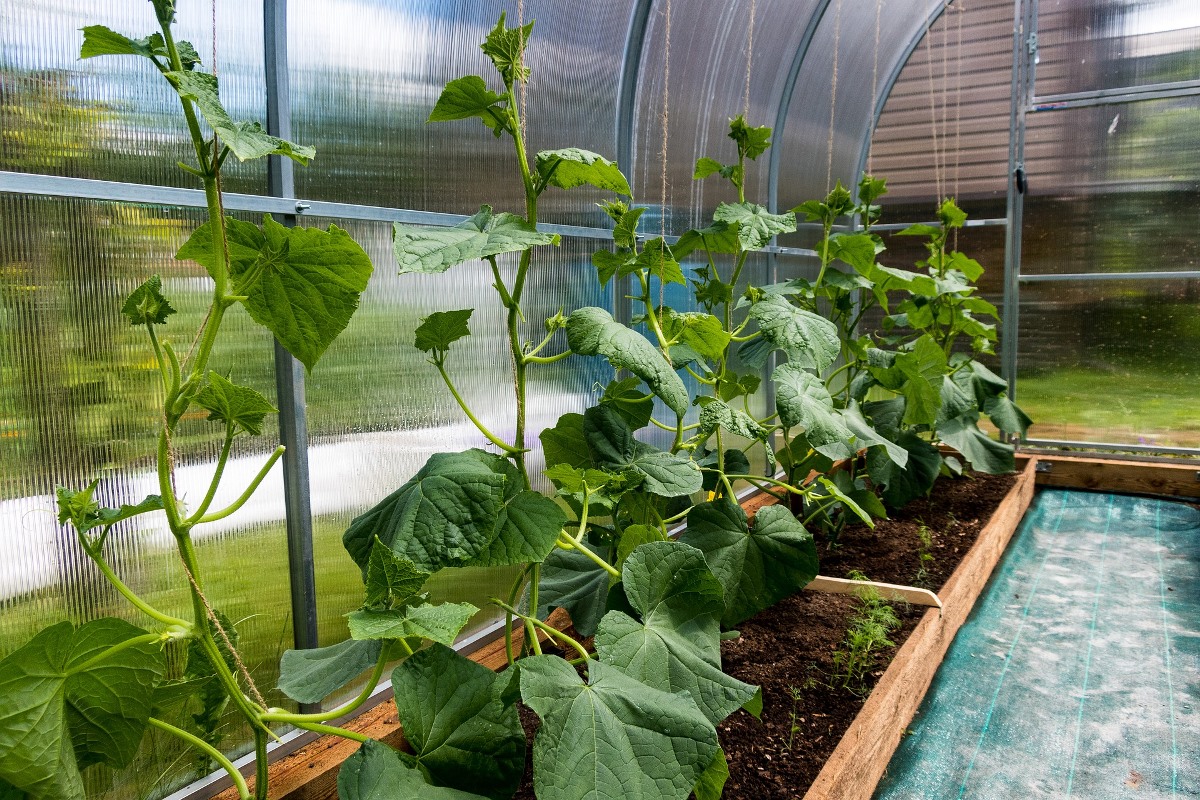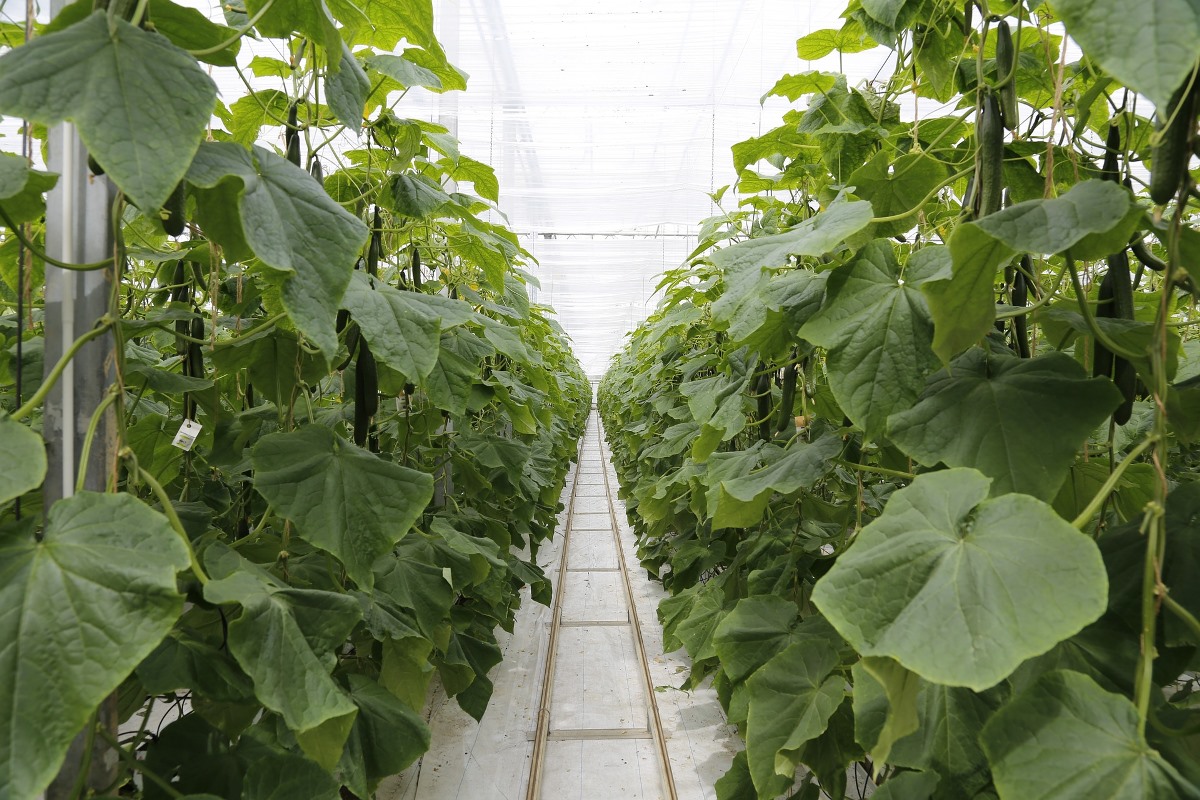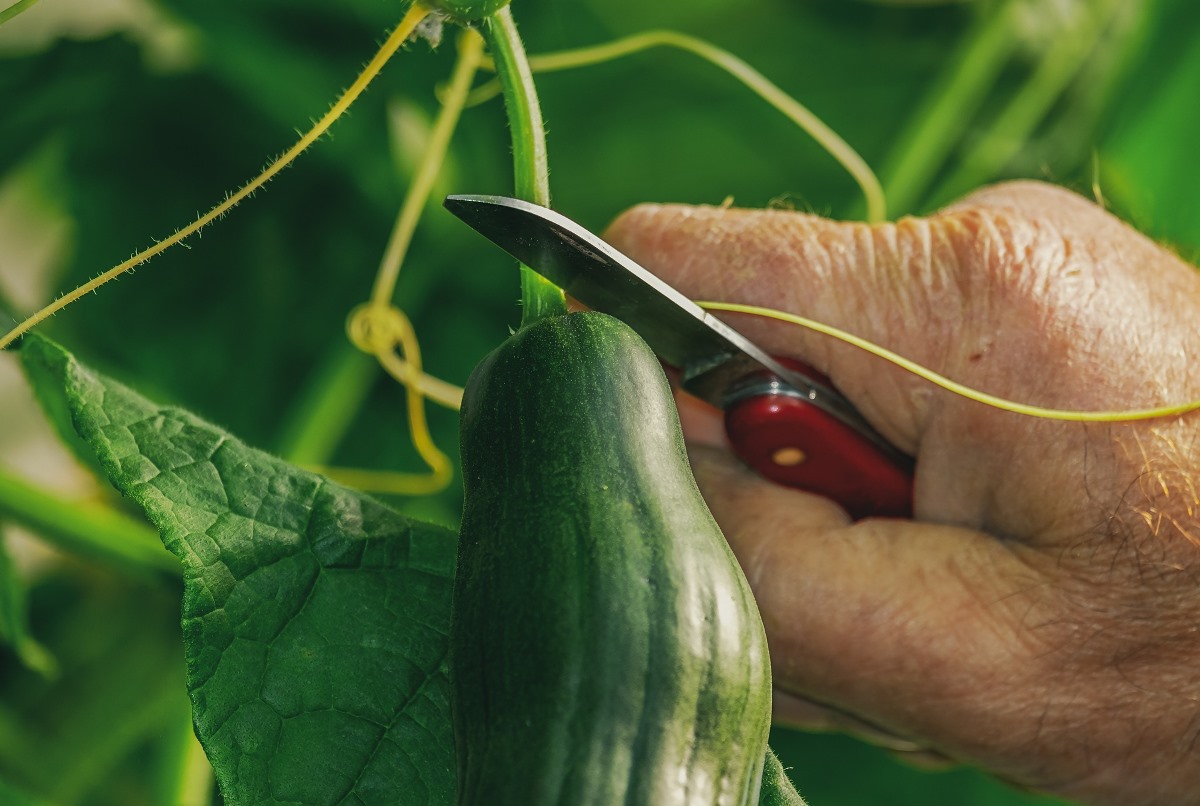Introduction to organic Cucumber farming in greenhouse
Cucumber is a warm-season; vining, annual plant in the family Cucurbitaceae has grown for its edible Cucumber fruit. The organic Cucumber plant is a sprawling vine with large leaves and curling tendrils. Cucumis sativus is the botanical name of Cucumber. Cucumbers are originated in India. Organic Cucumber is a climbing plant which is used as summer vegetable throughout in India. The Cucumber fruit is eaten raw or cooked as a vegetable or is served as a salad. Greenhouse Cucumber plants have large leaves and each plant is provided 5 to 7 square feet of space and is always grown on a trellis. Greenhouse Cucumbers need close monitoring of nutrients to maintain good health and productivity.
A step by step guide to organic Cucumber farming in greenhouse
Protected crops are less apt to be damaged by rain, wind, and hail so the percentage of marketable products is higher. Yield is higher as well if you can provide optimum growing conditions for each crop. Greenhouses protect crops from several diseases, mainly those that are soilborne and splash onto plants in the rain. And greenhouse crops may be protected from regular field pests. Greenhouse crops have their particular problems such as foliar disease, whiteflies, and aphids, so vigilance is still required.
Soil requirement for organic Cucumber farming in the greenhouse

It can be sown in a variety of soils ranging from sandy loam to heavy soil. But a loamy soil that is rich in organic matter and has a good drainage system is best for Cucumber farming. To maintain soil fertility and avoid negative environmental impacts, organic farmers can use a wide range of soil fertility management tools such as crop rotations, soil tillage practices, organic amendments, and agroecological services crops, but to be effective, they must be applied to less intensive production systems. Greenhouse Cucumbers grow quite well in a wide range of soil pH (5.5-7.5), but a pH of 6.0-6.5 for mineral soils and a pH of 5.0-5.5 for organic soils are generally accepted as optimum.
If the main objectives of organic greenhouse production are the same as conventional greenhouse production and the agronomic practices adopted are based on a simple substitution of synthetic inputs with allowed organic inputs, the negative consequences of unbalanced systems of production cannot be avoided. Moreover, the application to soil of huge quantities of organic amendments derived by the transformation of agricultural wastes can also have a negative environmental effect on soil and reduce the level of sustainability of such practice.
Location of Greenhouse for organic Cucumber farming
The perfect location for a greenhouse has moderate winter temperatures, high winter light intensity, low humidity, and easy access to markets. The easy availability of existing utilities will help decrease establishment costs and will affect ongoing fuel costs.
Greenhouses using a potted production system or native soil for vegetable production must be constructed on level sites with deep, well-drained soils. Sandy loams are best. A source of good-quality water is also important. High salt concentrations in either the soil or water can significantly reduce yields. Where soils are not suitable, growers may consider bringing in a better soil or using a soil-less production system.
Inside greenhouses, more favorable temperatures may be reached during the cold season, thanks to the windbreak effect and the greenhouse effect. During the warm season, especially in the Mediterranean and tropical areas, where there is high solar radiation and the temperature exceeds the recommended maximum threshold level, the greenhouse effect harms the microclimate and crop performance. However, these negative effects are to some extent compensated for by the shading effect and can be regulated to a certain extent by proper ventilation and/or cooling of the greenhouse.
The greenhouse effect is the result of two different effects:
- A confinement effect, resulting from the decrease in the air exchanges with the outside environment.
- An effect caused by the existence of a cover characterized by its low transparency too far-infrared radiation, but its high transparency to sunlight.
Climatic requirements for organic Cucumber farming in greenhouse
Cucumbers require warm soil and do not tolerate frost. Wait for warm spring days and soil temperatures above 16 °C, usually about 2 to 3 weeks after the last frost date. It’s a good idea to start seeds indoors about 3 weeks before you plan to put them in the garden.
Keep trellised plants 6 to 10 inches apart. When planted in hills and allowed to run, grow 3 plants to a 2-foot-wide hill with the hills spaced 6 feet apart. Apply an organic vegetable fertilizer in early spring, and then provide supplemental light feedings monthly throughout the gardening season.
The most commonly grown species in greenhouses are vegetables with medium thermal requirements; the aim is to extend the growing calendars beyond the conventional open-air cultivation season and thus increase profitability. These days, the production of greenhouse crops in geographical areas without suitable climate conditions is highly questionable since it entails significant and expensive artificial climate control. In any case, financial results determine the final selection of a greenhouse.
Cucumber plant spacing in greenhouse
Greenhouse Cucumber plants have large leaves, grow vigorously, and require large amounts of sunlight. Under good sunlight conditions, each plant must be provided 5 to 7 square feet of greenhouse space.
Greenhouse construction for organic Cucumber farming
Greenhouses can range from simple homemade designs to sophisticated prefabricated structures. Materials used to construct a greenhouse frame can be PVC, wood, steel or aluminum; coverings can be glass or flexible plastic or various rigid materials. Many factors should be considered when selecting a particular greenhouse design, not the least of which are local building codes. Make sure all building codes are met and necessary permits secured before construction begins. Structural load from environmental forces as well as for trellises must be considered in the design of a greenhouse. Sufficient cooling and heating capacity must be incorporated into the design to meet the crop’s needs for the given geographic location. Greenhouse construction costs may vary based on the materials and equipment used. Organic Cucumber was produced in construction with galvanized steel tubing. Water is available to the greenhouse. Thus, it might not need extra investment for the drilling of a water well. A water pump was used for irrigation.
The variable costs related to crop production are all inputs that directly relate to the production of Cucumbers. Variable costs identified as operating expenses are charges paid only if Cucumber production occurs. Variable costs change in proportion to the amount of production.
Process of organic Cucumber farming in greenhouse
You may also check this: Organic Lettuce Farming, Cultivation, Growing Process.

Step 1) Cucumbers are a warm-season crop; therefore, greenhouse temperatures should not be allowed to drop below 18°C. Seed germination can occur with media temperatures above 16°C, but optimal germination occurs at 29 to 35°C. Naturally, Cucumbers will be germinated in flats of rock wool or foam blocks, generally with a single seed per well to ensure plants can be transplanted with minimal root damage.
Step 2) Cucumber plants should be transplanted to final spacing in the greenhouse when they are large enough to handle without damage. They will usually be ready for transplanting in 2 to 3 weeks under optimal conditions.
Step 3) Cucumbers are vining crops, so they are grown with a trellis system. As the plant is trained, all fruit below 24 to 30 inches are removed to maximize foliar growth. Above this height, the fruit is allowed to set. Different types of trellis systems have been developed to produce greenhouse Cucumbers. These systems, using either 1 or 2 wires strung approximately 8 feet above the crop, are referred to as single and V-cordon systems. Both single and double rows of plants can be used with the single cordon system. In either case, the plants are trained up a string to the suspended wire where the plant is draped over the wire. At this time, the plant may be pinched and two laterals allowed to grow down to the ground, or the primary stem may be allowed to continue growing to the ground. In either case, all other laterals are removed as they appear and at least one fruit is allowed to develop at each node. In the V-cordon system, 2 wires are suspended so that the plants can be alternately strung to one wire or the other. This results in a V-shaped system of plants growing to the corresponding wires. In all other ways, they are treated the same as the single-wire system in terms of pruning laterals and draping over the wire.
Step 4) The in-row spacing will differ between the two systems. In the single cordon system, plants are spaced 12 to 18 inches apart. If a single wire with a double row is used, the plants are spaced 18 to 24 inches apart with 2 feet between the double rows. With the V-cordon system, the plants are spaced 12 inches apart with plants alternatively strung to one wire or the other. Between-row spacing for the double-row single-wire system is 5 to 6 feet; for the single-row single-wire system, 4 to 5 feet. With the V-cordon system, between-row spacing is 5 feet.
Step 5) Fruit matures continuously as the plants grow. Flower opening to harvestable fruit will take between 10 and 14 days. Therefore, harvesting is a continual process usually done three times a week. Harvested fruit must be protected from desiccation and bruising because the skin is rather tender and prone to water loss. Greenhouse Cucumbers are individually shrink-wrapped to restrict desiccation and extend shelf life. This is a labor-intensive process.
Feeding and irrigation requirement for organic Cucumber farming in Greenhouse
Watering and feeding Cucumber vines are simple tasks. Just apply good organic fertilizer early in the season and make sure established vines get a deep application of water twice a week (by hose or rain). The next consideration is deciding whether or not to trellis your plants. It should be emphasized that the availability of water (in sufficient quantity and of good quality) is an essential requirement for greenhouse growing of high added value crops.
Cucumbers are a close relative of the watermelon and they need tons of water to thrive. Keep your plants provided with one to two inches of water a week, especially during periods of rapid growth when they are flowering. Mulches are especially useful for keeping water in the soil and preventing your plants from drying out. Your best strategy is to keep the soil slightly moist at all times while preventing the vines from getting too wet. For this reason, drip irrigation is a good idea. If you must use overhead watering, use it in the early morning so that the leaves have plenty of time to dry out before evening.
As much as Cucumbers love water, they love feeding even more. Keep your plants satisfied with consistent applications of organic fertilizers and mulches. Top dress your Cucumbers with compost, kelp, alfalfa, and neem cake throughout the growing season to stop them from facing a nitrogen deficiency. The drainage conditions must be good, especially in regions of high rainfall. Places with a high-water table must be avoided.
pests and disease control in greenhouse organic Cucumber farming
Organic farming is one of several approaches to sustainable agriculture, and organic greenhouse vegetable production has potential as a niche market for out-of-season produce, excluding the use of synthetic fertilizers, growth regulators, pesticides, and transgenic seeds. Organic producers rely heavily on crop rotations, animal manures, crop residues, legumes, green manures, organic wastes, and mineral-bearing rocks to fertilize the soil and supply plant nutrients.
The disease incidence was low since the microclimatic conditions within the greenhouse, such as aeration, were unfavorable for fungal growth. Powdery mildew that developed during the growing periods might be controlled easily by removal of the leaves and the use of sulfur. Inorganic Cucumber production, pest problems appeared mainly on plants that were close to the entrance, thus signifying the need for effective sanitary measures.
The most common pest for Cucumbers that all those harmful chemicals are being used to keep away is the Cucumber beetle. Get rid of them without using toxins by creating yellow sticky traps. These disease-carrying beetles are attracted to the yellow color. Without Cucumber beetles to worry about, you should find growing Cucumbers a healthy, pleasant and, alternative.
When and how to harvest Cucumbers
In case if you miss this: Organic Guava Cultivation, Farming Practices.

The size that you harvest your Cucumbers depends on the particular variety you are growing, so be sure to look carefully at the instructions on your seed packets. Cucumbers self-regulate how many fruits they grow at a time, and allowing fruits to over-ripen on the vine tells the plant that it has achieved success in creating offspring and that it doesn’t need to produce more fruit. To prevent this from happening, pick your Cucumbers daily and as soon as the fruit reaches a harvestable size.
Cucumbers should be harvested from the plant when they are still immature and green in color. The size of organic Cucumbers at harvest based on the variety of the Cucumber being grown and what it is to be used for. Cucumbers for pickling are generally picked when they are less than 5 cm long whereas burpless Cucumbers for slicing should be allowed to reach approximately 4 cm in diameter. It is important to remove any fruits nearing maturity to ensure the plant remains productive. Their rapid growth means that organic Cucumbers may require harvested every couple of days.
In case if you are interested in this: How To Grow Chilli Plants At Home.